

Fighting for new laws to protect women in Japan. Emilie Wapnick: Why some of us don't have one true calling. How sustainable design is revolutionizing our daily lives. Arturo Vittori @TEDxCibeles photo: Carmen Acevedo Olivie It is projected that by the year 2050, 66% of the world’s population will be living in cities.
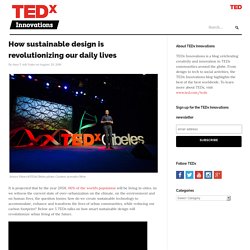
As we witness the current state of over-urbanization on the climate, on the environment and on human lives, the question looms: how do we create sustainable technology to accommodate, enhance and transform the lives of urban communities, while reducing our carbon footprint? Below are 5 TEDx talks on how smart sustainable design will revolutionize urban living of the future. Rethinking urban mobility | Ryan Chin | TEDxBoston In 2009, with climate change on the rise and the automobile industry at a decline, Ryan Chin suggested an alternative: more sustainable and affordable means of transport for city dwellers.
Stefano Mancuso : "Les plantes sont capables de voir !" Les plantes nous regardent.
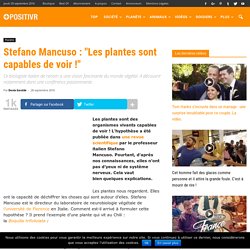
Elles ont la capacité de déchiffrer les choses qui sont autour d’elles. Stefano Mancuso est le directeur du laboratoire de neurobiologie végétale de l’université de Florence en Italie. Comment est-il arrivé à formuler cette hypothèse ? Il prend l’exemple d’une plante qui vit au Chili : la Boquilla trifoliolata : « Cette plante a une extraordinaire capacité au mimétisme.
Cette étude de Stefano Mancuso se base sur un principe qu’il énonce ainsi : « Pour que l’on puisse imiter, on a besoin de connaître ce que l’on veut imiter. » Stefano cote un autre exemple : la Arabidopsis, une plante de laboratoire. « Quand on isole cette plante sous une cloche en verre, son comportement change en fonction de la plante que l’on met à ses côtés. Alors, les plantes ont-elles des yeux ? « Ce ne sont pas vraiment des yeux, mais des lentilles qui ont la capacité à partir de la feuille de transporter les rayons de la lumière et des images qu’elles reçoivent. » How to turn small talk into smart conversation. Imagine almost any situation where two or more people are gathered—a wedding reception, a job interview, two off-duty cops hanging out in a Jacuzzi.
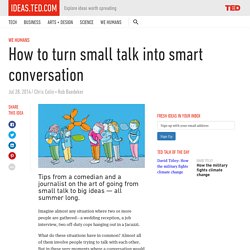
What do these situations have in common? Almost all of them involve people trying to talk with each other. But in these very moments where a conversation would enhance an encounter, we often fall short. We can’t think of a thing to say. Or worse, we do a passable job at talking. We stagger through our romantic, professional and social worlds with the goal merely of not crashing, never considering that we might soar. We at What to Talk About headquarters set out to change this. Ask for stories, not answers. What color is Tuesday? Exploring synesthesia - Richard E. Cytowic. Brian Little: Who are you, really? The puzzle of personality. Fear is boring, and other tips for living a creative life. Creativity is a tricky word.

Consultants peddle it, brands promise it, we all strive for it, often without really knowing quite what “it” really is. Put simply, there’s a lot of snake oil around creativity. But now here’s author Elizabeth Gilbert (TED Talk, Your elusive creative genius) to cut through the guff with her distinctly refreshing take on the topic. For her, we’re all creative souls already, we just need to figure out how to harness inspiration and unleash the creative spirit within. Here, she shares her best pieces of advice for living a meaningfully creative life. 1. How many times have you heard someone say, “I don’t have a creative bone in my body.” 2. The magical thinking that I use to engage with creativity is this idea that inspiration does not come from me, it comes to me. 3.
Laura Robinson: The secrets I find on the mysterious ocean floor. Kamal Meattle: How to grow fresh air. Rachel Sussman: The world's oldest living things. What if we could clean wastewater with corn cobs? 15-year-old TEDxVienna speaker Lalita Prasida worked with farmers in India to develop a wastewater filtration system using corn cobs (Photo: Lalita Prasida) Fifteen-year-old Lalita Prasida was in school when she realized that — in many places around the world — potable water is a luxury.
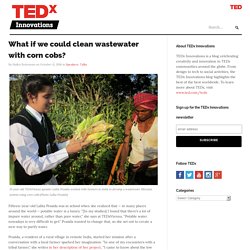
“[In my studies] I found that there’s a lot of impure water around, rather than pure water,” she says at TEDxVienna. “Potable water nowadays is very difficult to get.” Prasida wanted to change that, so she set out to create a new way to purify water. Prasida, a resident of a rural village in remote India, started her mission after a conversation with a local farmer sparked her imagination. Farmers burned or dumped the inedible cobs, creating environmental pollution and waste that doesn’t biodegrade for a “long, long time,” Prasida says. She set out to find out. Grow plants without water. Alice Moynihan Ever since humanity began to farm our own food, we’ve faced an unpredictable frenemy: rain.
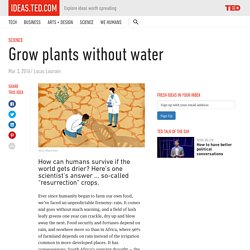
It comes and goes without much warning, and a field of lush leafy greens one year can crackle, dry up and blow away the next. Food security and fortunes depend on rain, and nowhere more so than in Africa, where 96% of farmland depends on rain instead of the irrigation common in more-developed places. It has consequences: South Africa’s ongoing drought — the worst in three decades — will cost it at least a quarter of its corn crop this year.
Biologist Jill Farrant (TED Talk: How we can make crops survive without water) of the University of Cape Town in South Africa says that nature has plenty of answers for people who want to grow crops in places with unpredictable rainfall. Extreme conditions produce extremely tough plants. Farrant calls them resurrection plants. The big difference between “drought-tolerant” flora and these tough plants: metabolism.